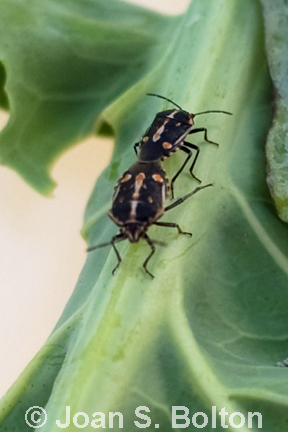
A destructive new insect, seemingly out of nowhere, is wreaking havoc on local organic growers and home gardeners.
Over the last six weeks or so, literally hundreds of thousands of Bagrada hilaris bugs have descended on a host of edibles growing in fields across Santa Barbara County and begun methodically sucking the life out of them.
“We lost all the plants in our early plantings of broccoli, cauliflower, anything in the brassica family, Brussels sprouts, all the kale,” said Mark Tollefson, Executive Director of the Center for Urban Agriculture at Fairview Gardens in Goleta. “Over the course of a week, we watched the plants curl up and die.”
Other organic gardeners from Carpinteria to Santa Ynez are suffering losses as well, primarily to members of the brassica family, but also to bok choy, cilantro, peppers and even corn.
“They also are eating weeds, mustard and alyssum. They’re feeding on the plant juices,” said Brian Cabrera, an entomologist at the Santa Barbara County Agricultural Commissioner’s Office. “I have heard that there’s a toxin (in their saliva) that they inject, but I don’t know if they’re actually that toxic to the leaf. I think mainly the damage is from hundreds of these bugs on a single plant, jabbing their little needle-like mouth parts and sucking it dry.”
What to Look For
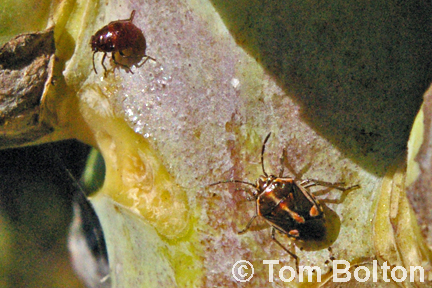
At first glance, bagrada bugs look like small, dark ladybugs, which of course are fantastic beneficial insects.
But that’s actually their nymph stage, when they’re relatively round, and a two-toned black and red. In a matter of days, they morph to their next stage, in which their bodies elongate and develop distinctive pale, orangish stripes, spots and other marks. Then they begin mating — with the female the larger of the pair — and the cycle begins anew.
In my garden, we first spotted the nymphs on our Brussels sprouts and late-season corn a week ago last Sunday. The adults began emerging a few days later and had begun mating by Friday. We haven’t seen the small, round jelly-like eggs yet, but don’t imagine that it will take long for them to appear. According to Cabrera, a single female can lay about 100 eggs during her lifetime.
Where They Come From

Bagrada bugs are native to east and southern Africa, Egypt, Zaire and Senegal, according to the Center for Invasive Species Research at UC Riverside. They first appeared four years ago in Los Angeles County and rapidly spread through southern California and southern Arizona.
The infestation at Fairview Gardens in mid-August was quickly followed by reports to Cabrera from Solvang, the Mesa, Mission Canyon and other parts of Goleta.
“Then a couple weeks ago, we started getting calls from some of the growers, organic growers especially,” Cabrera said. “They’re getting hit pretty hard. They can’t use some of the materials that the nonorganic growers can use.”
Indeed, conventional farmers are combating — and controlling — bagrada bugs with pyrethroids and organophosphates like chlorpyrifos and malathion, according to Surendra Dara, a strawberry and vegetable crops advisor and affiliated IPM advisor for UC Cooperative Extension for Santa Barbara and San Luis Obispo Counties.
The trouble is, the bugs are so new to scientists that they haven’t yet figured out much in the way of organic controls, Dara said.
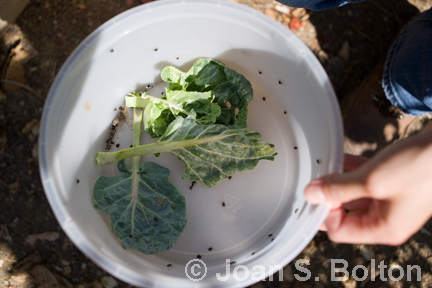
“Because of the kind of bug it is and its life cycle, it can be a little tricky to develop a strategy to target its vulnerable stages,” he said. “The organic growers, the small gardeners, homeowners, they don’t have resources that farmers have. So for organic farms, you don’t have as many options.”
But that doesn’t mean growers like Tollefson are throwing in the towel. He plans to wait another week before planting another round of cool-season crops. In the meantime, he’ll work through a list of tasks, starting with mixing diatomaceous earth with water, then spraying it on the ground.
“I don’t know the exact pathology, but I do know that bugs that are in contact with it die,” he said. “Bagrada bugs dive into the ground. So sprinkling diatomaceous earth around the soil can be helpful as far as managing them.”
Tollefson also plans to interplant strong-scented garlic and onions with his brassicas, and to wait until his starter plants are 6 to 9 inches tall — instead of just a few inches — before putting them in the ground. His thinking is that the larger plants will be more robust, thereby have a better chance of withstanding the bugs.
Another tactic is to break up the soil. “When temperatures drop below 50 degrees or get very, very hot, the bugs get sluggish. At that point, they stay in the soil,” he said. “Tilling the soil grinds them up. I have a big rototiller. It’s 70 inches wide.”
Weed control is important as well, he said. He might try planting a few sacrificial or trapping crops to intentionally attract the bugs, then kill them “in a natural way.”
Also important is building soil fertility, he added. “The more healthy the plants, the more opportunity we have to beat the bug.”
In Home Gardens
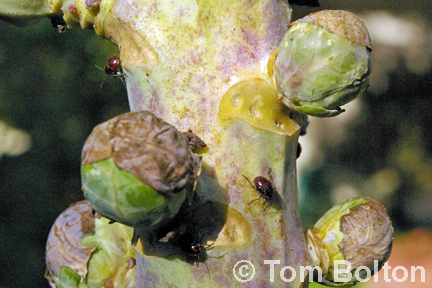
For home gardeners whose vegetables are already infested, Cabrera suggested spraying the afflicted plants with a 1% or 2% insecticidal soap solution. In addition, he said, “Vacuuming them off is worth a try.”
For folks who are getting ready to sow their cool-season vegetables from seed, Cabrera recommended turning the soil first, to destroy any eggs, then installing row covers immediately. His advice holds for planting seedlings, too.
“If you determine that your plants are bug-free and egg-free, then put up row covers,” he said. “Make sure that the covers aren’t lying on the plants because the bugs can eat through that. Raise up the covers through hoops or pipes, then bury the edges because (otherwise) the bugs can crawl under.”
As for what lies ahead, Cabrera said, “I don’t know how long they’ll be around. If the weather cools off, the activity will drop off because they don’t seem to be active on cooler days. It remains to be seen within the next few weeks what’s going to happen.”
As far as scientific research into organic controls: Dara is launching a study this week, thanks to scores of bagrada bugs that Maria Murrietta, a UC Cooperative Extension agricultural technician, collected from my ailing Brussels sprouts and corn plants on Friday.
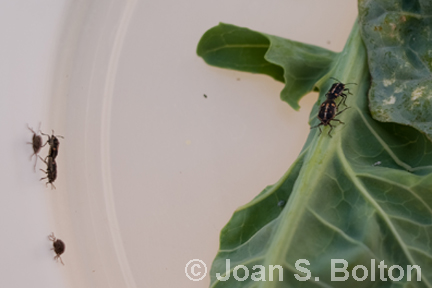
It was a happy day, to donate so many destructive bugs to science.
Over the new few weeks, Dara will subject those bugs to a mix of products, with the aim of determining whether any organic methods have the potential to successfully control and/or kill the bugs.
In the meantime, Tollefson is philosophical about the challenge.
“So yeah, it’s a big deal to lose these crops,” he said. “But the reality is, it’s one more thing to deal with. It’s significant enough that we can’t ignore it. (But) we’re farmers. We’ll adapt to this bug.”
≈
This article also appears at Noozhawk.com.
Copyright, Joan S. Bolton. All rights reserved. Reproduction of text or photos in any form is prohibited without written permission.
≈
